On our visit to Joel Dean’s studio several works, some finished, some still working towards culmination, surrounded us. Our conversation meandered around them as much as their presence did the same with us. We played catch up with the various paintings and objects covering the surfaces of the room, as each slowly began to reveal itself.
Joel talks about time both as a determining factor in his life as an artist and as a concept among many that is incorporated into the work itself. Time is something to be broken down and played with, examined as a single thing which is different than the sum of its parts. Imagine isolating a musical crescendo exactly at the moment of its apex. What does a single moment mean and can it be stripped of its surrounding conditions? Or to take another unit whose implications stretch far and wide in life and specifically here in Joel’s body of work: letters. Imagine what image or object a single letter is worth. Can it be dissociated from language? As with other units that Joel deals with in his sculptures and paintings—money, capital, keys on a piano—such questions and their implications unravel. In Joel’s hands, these become elemental tools, like building blocks for an architect.
Joel talks about time both as a determining factor in his life as an artist and as a concept among many that is incorporated into the work itself. Time is something to be broken down and played with, examined as a single thing which is different than the sum of its parts. Imagine isolating a musical crescendo exactly at the moment of its apex. What does a single moment mean and can it be stripped of its surrounding conditions? Or to take another unit whose implications stretch far and wide in life and specifically here in Joel’s body of work: letters. Imagine what image or object a single letter is worth. Can it be dissociated from language? As with other units that Joel deals with in his sculptures and paintings—money, capital, keys on a piano—such questions and their implications unravel. In Joel’s hands, these become elemental tools, like building blocks for an architect.
![]()
![]()
Initial J and the Transformative Power of Symbolism in Storytelling, 2021
oil on canvas, 64 x 48 inches


When did you start making work?
As long as I can remember I wanted to make art. My parents are art school dropouts and have always been very supportive of my being an artist. Although the second I graduated from art school, my dad immediately asked me, “so how are you going to make money?” He’d never pushed me to consider that before.
As a teenager, I took courses at Atlanta College of Art. I obviously wouldn’t say I was making work then but I've been oil painting since I was a teenager. I feel very comfortable with the medium, although at this point, after so many years, I have this specific way I do it, and it doesn't always work out. I feel a little cornered in the painting process I’ve created for myself. I went to SAIC in Chicago, and they have this great artist book collection called the Joan Flasch Artist Book Collection. I worked there for most of my time in Chicago.
I only took one sculpture course, but I spent so much time around artist books and catalogs about conceptual art that I started to get into that. And then through visual and critical studies classes and art history classes, my interest in that side of the art world grew. It's been difficult reckoning those two things. Having grown up painting, being interested in the history of representational images, while also having the desire to create work that pushes up against or plays with the line between reality and a kind of mediated reality—working to blur that line.
Right, you can decontextualize with sculpture, where painting is static.
Yeah, it becomes an image, exactly. When I moved to California, I opened up a space with some friends called Important Projects, and I ran that gallery for five years before I moved to New York in 2014. During that time, probably two years into running the space, I basically quit painting completely. I was working retail to make ends meet. And while running the space actually wasn’t that much of a time sacrifice, the job was so taxing that I just couldn’t find the time to paint. Painting requires so much failing, and having the time to fail; or at least the painting that I’m interested in making requires that.
I’d been dabbling with sculpture in the years leading up to that moment, but it was settling into an economy of time outside the shelter of academia, that led me to begin thinking about art in a different way. Around this moment is probably when I really started making work? Even if it wasn’t very good. The earliest sculptures I made were ready-made works, made with found objects or store-bought things, and the work, as I was imagining it, was rearranging these objects in specific contexts. When I look back on that earlier work, I was writing about it, but I don’t know how relevant the writing was… it's taken a long time for me to understand what I was doing, not to suggest that I can articulate it perfectly now.
I’d been dabbling with sculpture in the years leading up to that moment, but it was settling into an economy of time outside the shelter of academia, that led me to begin thinking about art in a different way. Around this moment is probably when I really started making work? Even if it wasn’t very good. The earliest sculptures I made were ready-made works, made with found objects or store-bought things, and the work, as I was imagining it, was rearranging these objects in specific contexts. When I look back on that earlier work, I was writing about it, but I don’t know how relevant the writing was… it's taken a long time for me to understand what I was doing, not to suggest that I can articulate it perfectly now.
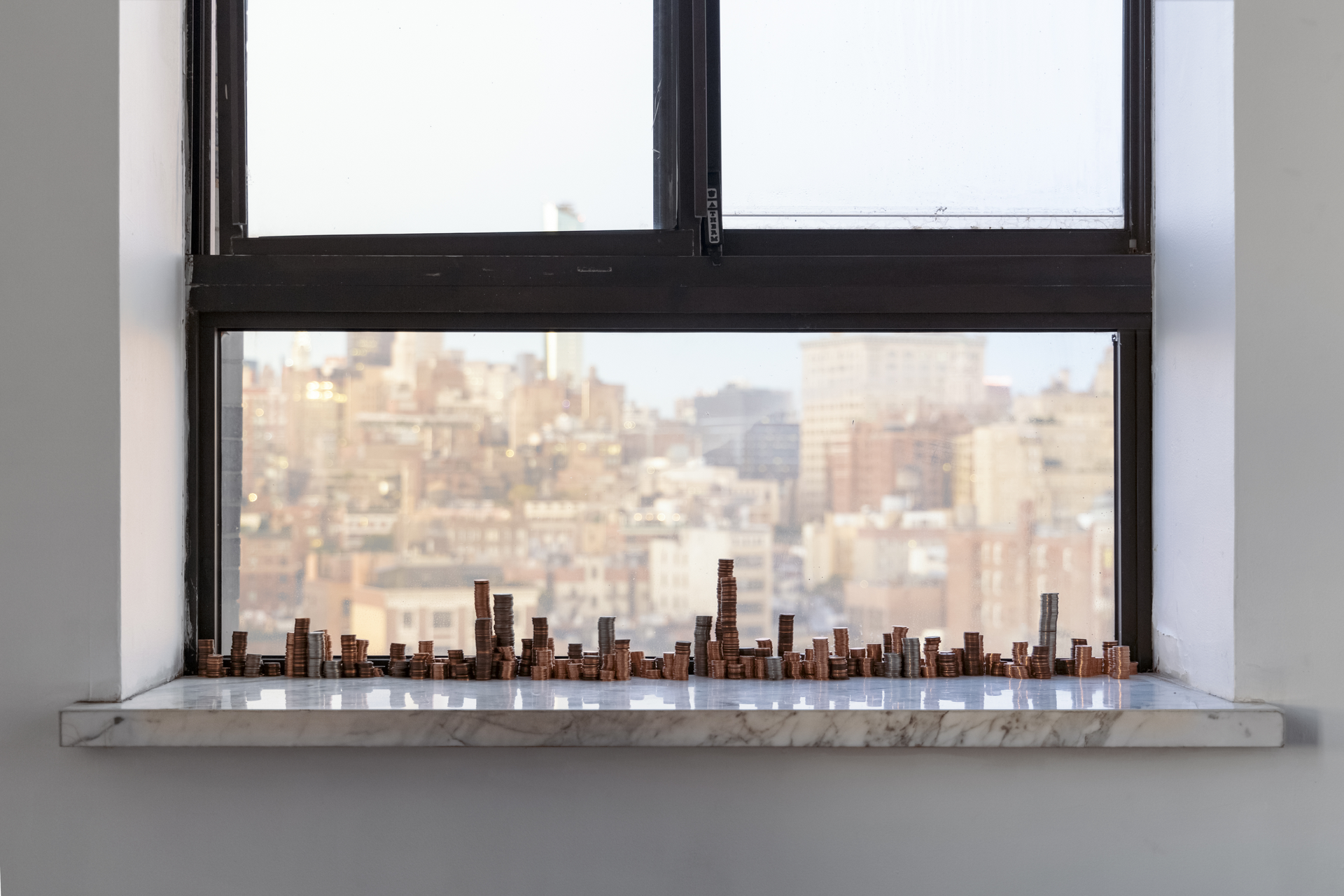
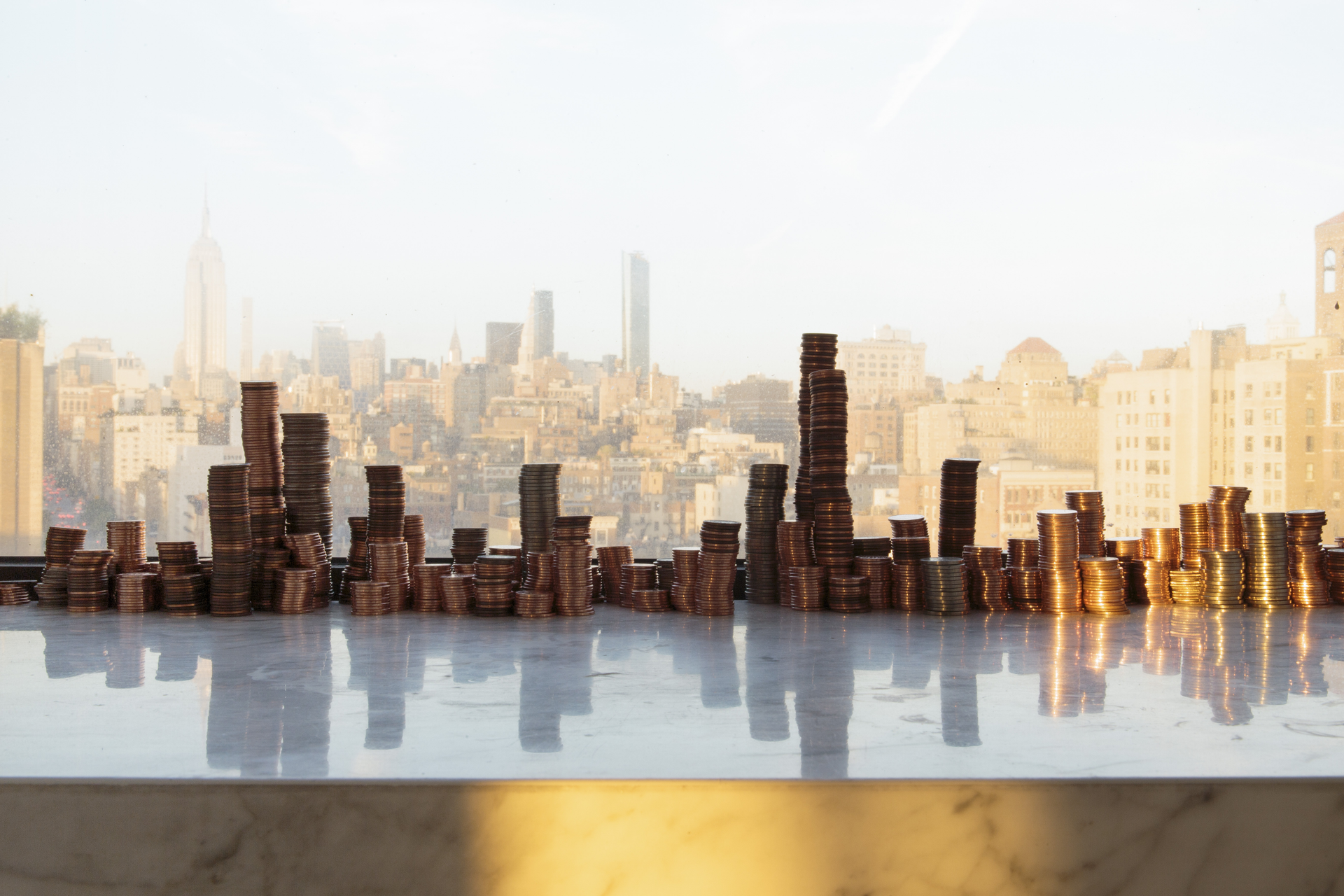
The Anatomy of Out of Body Experience in Human Capital Organization Systems and Planning Culture after the Age of Discovery, 2017,
160 quarters, 500 dimes, 14200 pennies
Are you referring to the stacks of pennies [The Anatomy of Out of Body Experience in Human Capital Organization Systems and Planning Culture after the Age of Discovery, 2017]?
Actually, that’s from after I moved to New York in 2014, but yeah I’d consider that to be a part of this earlier body of work. Right before that, in 2013, I had a solo show in LA and that was my first moment of “okay, I’m making sculpture now, fully.” Then I moved to New York. I was a professional driver for a year and a half. Driving 8-12 hours a day… you end up with alot of thinking time. But it also created this weird micro-vascular relationship with the city. I would end up at the base of the World Trade Center multiple times a day, but then I would go out as far as Connecticut. My income was following the rhythm of the nine to five grind. Seeing the city up close and from far away every day, began to feel like a pulse. I also became hyper-aware of where capital was accumulating in the city, and the trail of it. The penny work is related to that experience.
The penny also relates to the way I think about the alphabet as this elemental unit of something that can, carry information, and through accumulation and time, transform into something else. One thing I'm always thinking about in my studio is the difference between a grain of sand and the sand dune, and the eventual possibility of an avalanche. Although they are, on their face, both made of silica, the physical properties of a grain of sand are totally different than a pile of sand. There’s this concept of the moment in which you add the grain of sand in which the dune breaks and that's when it becomes physically identifiable as a new body. I think about that in my paintings especially, but over time I realized I was doing that in my sculptures as well. There's always multiples, and the pieces are made of individual aspects that have the potential to transcend their original form, by becoming something larger than themselves together.
The penny also relates to the way I think about the alphabet as this elemental unit of something that can, carry information, and through accumulation and time, transform into something else. One thing I'm always thinking about in my studio is the difference between a grain of sand and the sand dune, and the eventual possibility of an avalanche. Although they are, on their face, both made of silica, the physical properties of a grain of sand are totally different than a pile of sand. There’s this concept of the moment in which you add the grain of sand in which the dune breaks and that's when it becomes physically identifiable as a new body. I think about that in my paintings especially, but over time I realized I was doing that in my sculptures as well. There's always multiples, and the pieces are made of individual aspects that have the potential to transcend their original form, by becoming something larger than themselves together.
![]()
![]()
The Transformative Power of Symbolism in Storytelling, 2022
ostrich egg, alphabet pasta, squid ink
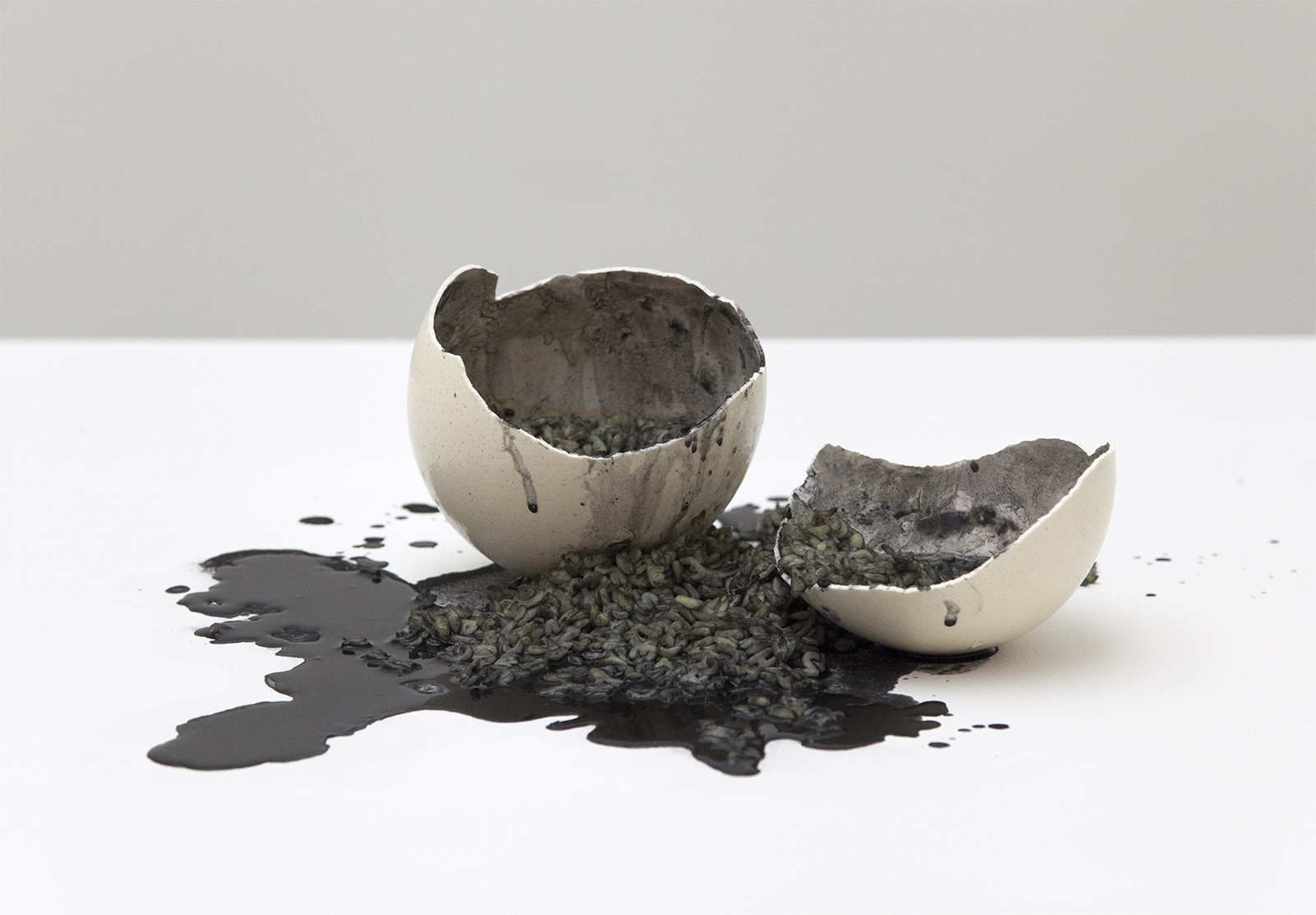

Does that concept apply to one of the earlier sculptures, The Transformative Power of Symbolism in Storytelling?
Yeah.
I see the egg as a recurring symbol in your work, and how that also relates to time. In some of your press releases, you talk about a flatness of time, or the necessity of time to allow things to happen so that everything's not happening at the same time. It kind of feels, maybe cliche, but the idea of the chicken and the egg, but also the egg as this idea of the potential of a chicken.
Yeah, I like that.
And that title is the same as the paintings in your later series.
Yeah…that phrase has been burnt into my mind for a while now, but yes it was originally for the egg piece. And the egg piece was very much meant to be in relationship to the idea of an origin story. Or about that concept. I was interested in the idea that in this sludge of alphabet were the pieces of all possible vocabularies, the potential for every story. The letter paintings are of course connected, but I don’t think about those paintings as “the chicken” to “the egg” so to speak. That would be too neat a narrative. I want to continue the line of inquiry those works carry but perhaps the next time I use the title it will be with the intention of bringing some entropy to the table.
“I was interested in the idea that in this sludge of alphabet were the pieces of all possible vocabularies, the potential for every story.”
In the press release for the alphabet series [Initials A through Z and The Transformative Power of Symbolism in Storytelling], the idea of the Aleph being the beginning, but also encompassing the entirety and multiplicity of God, was really striking to me.
I loved that piece of writing by Gabrielle Jenson. I was lucky to have her bring her thoughts to the paintings. A letter is a picture but also a unit that represents a phonetic sound. I still get stuck on the idea that every letter is just a human-made shape representing some elemental earth frequency that we’ve distilled, named and employed in a play of connections. Like with the onomatopoeia of a lightning strike sounding like the word lightning. I understand, or maybe misunderstand letters in the same way. I’m not sure that the letter paintings deal with this idea concisely but it was part of the inspiration. If every letter is a vessel carrying the narrative of its own evolution, then what can be drawn out by starting with a letter’s structure and intuitively building from its form. As I was working through the alphabet, with each painting I was not only working with the form of the letter but also with all the imagery that’d materialized in the previous paintings. So a language internal to the paintings began to develop, with repeating shapes, images, and recurring characters throughout.
![]()
![]()
Initial V and the Transformative Power of Symbolism in Storytelling, 2022
oil on canvas, 64 x 48 inches
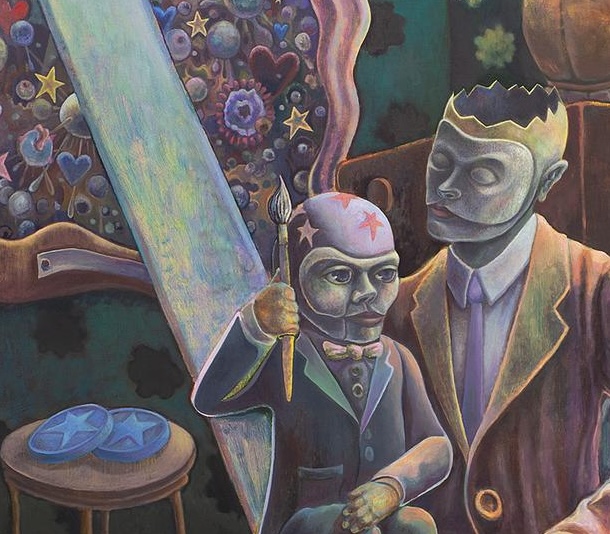

Can you talk about these recurring characters within the alphabet series?
Yeah, the early characters are the star-heads and the snow people. Talking about this is a little embarrassing—you have to remember, the first letter paintings were made during the period of the shutdown in which everyone was isolating. I was in the studio every day for like six months straight, not seeing anyone. I was here at 7am every day during that time, and all I was doing was painting.
The letter series was fundamentally about the idea of a beginning because I was waiting for the world to begin again. It was also a kind of love letter to the world, while the world was not available to us. I was interested in creating a representation or a stand-in for humanity. The star-heads position their viewers on the outside of the night sky looking down into it. It's about the way that, for millennia, humans understood or knew the sky as well as we now know the characters of primetime television. There's this great trilogy by Peter Sloterdijk, it's called The Sphere Trilogy. I was reading Bubbles: Microspherology, the first book in that trilogy at the time. The idea of Earth as a bubble is a recurring theme, and he uses this metaphor to articulate our relationship to the stars in connection to the narrative of the development of civilization. This idea, that everything happened in relation to the stars for millennia, is such common knowledge that it’s almost a faux-pas to bring it up. It’s taken for granted and the fact that the stars have become seemingly completely irrelevant to the way humanity organizes itself now… I think it’s actually difficult for people, myself included to imagine the actual scope of their impact on how we got here. Now our practice of pattern recognition regarding the stars is primarily through pop culture astrology. I follow that as well, for fun, but in the paintings I was thinking more about how the stars were both a clock and a history. The way that through them we can look forward and back at the same time. They carry a calendar, allow seasonal planting schedules, but also more complex information, like stories, through which we pass on intergenerational knowledge.
The snow people are meant to be humanity’s paradoxical and ineffectual idea of itself. They’re always melting. At some point the “empty heads” arrived in the paintings, They can be thought of as non-believers, vessels, non-playable characters, humans with no interiority. All these characters are supposed to be archetypal ideas about the human desire for narrative and image-making. Some of the characters have masks… I don't want to dress it up as anything except for what it is, which is just the idea of superficial representation. The world appeared to be ending, and I think I was interested in blindly leaning into these cross-cultural cliches. The letter paintings are more about the potential of narrative through all these symbols than any kind of concrete narrative.
The letter series was fundamentally about the idea of a beginning because I was waiting for the world to begin again. It was also a kind of love letter to the world, while the world was not available to us. I was interested in creating a representation or a stand-in for humanity. The star-heads position their viewers on the outside of the night sky looking down into it. It's about the way that, for millennia, humans understood or knew the sky as well as we now know the characters of primetime television. There's this great trilogy by Peter Sloterdijk, it's called The Sphere Trilogy. I was reading Bubbles: Microspherology, the first book in that trilogy at the time. The idea of Earth as a bubble is a recurring theme, and he uses this metaphor to articulate our relationship to the stars in connection to the narrative of the development of civilization. This idea, that everything happened in relation to the stars for millennia, is such common knowledge that it’s almost a faux-pas to bring it up. It’s taken for granted and the fact that the stars have become seemingly completely irrelevant to the way humanity organizes itself now… I think it’s actually difficult for people, myself included to imagine the actual scope of their impact on how we got here. Now our practice of pattern recognition regarding the stars is primarily through pop culture astrology. I follow that as well, for fun, but in the paintings I was thinking more about how the stars were both a clock and a history. The way that through them we can look forward and back at the same time. They carry a calendar, allow seasonal planting schedules, but also more complex information, like stories, through which we pass on intergenerational knowledge.
The snow people are meant to be humanity’s paradoxical and ineffectual idea of itself. They’re always melting. At some point the “empty heads” arrived in the paintings, They can be thought of as non-believers, vessels, non-playable characters, humans with no interiority. All these characters are supposed to be archetypal ideas about the human desire for narrative and image-making. Some of the characters have masks… I don't want to dress it up as anything except for what it is, which is just the idea of superficial representation. The world appeared to be ending, and I think I was interested in blindly leaning into these cross-cultural cliches. The letter paintings are more about the potential of narrative through all these symbols than any kind of concrete narrative.
![]()
![]()
![]()
Initial A and the Transformative Power of Symbolism in Storytelling, 2021
oil on canvas, 64 x 48 inches



That makes sense. You can get really familiar with the characters in the works as they relate to each other. What's interesting about it is that it almost gets the ball rolling with a narrative, that moment of a beginning.
That's true, they never take off. I feel like that quality puts them in relationship to how Drop Cap initials operated in early print media. They encapsulate “beginning”..
The series is like tarot cards, because each painting has different possibilities of interpretation and meaning. By being in conjunction with each other and placed in relation to one another, they create different kinds of meaning, in the same way that even the alphabet works.
I love that. That's kind of how I think about my sculptures as being interchangeable. I think this idea of world-building may be overused in some ways because that’s what any artist is doing. But it does feel present in my work and I think about the sculptures as units within a larger world, and different groupings of them can mean different things.
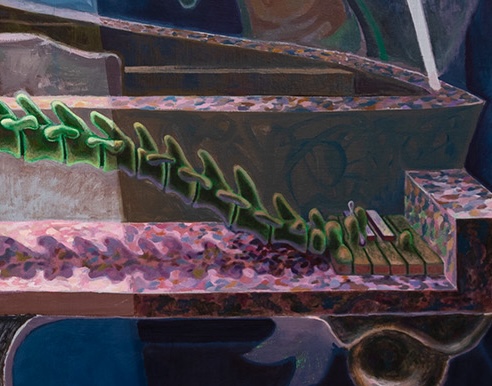

Notes on the Fall of Emphasis (All that thinking time...), 2024
oil on canvas, 48 x 63 inches
What’s going on with your recent piano paintings?
They’re about the relativity of time, but ironically, as paintings, I feel like they don’t belong to this moment. Sometimes I try to look at them through retrospect… or imagine them as being from a specific past, to consider how compelling I might find them. Hopefully, time will be generous to them, but yeah they feel totally out of sync with what seems to be popular in painting right now. There’s a coldness in contemporary painting that feels born in the algorithmic digestion of photographic images. I think about my paintings as objects, in the same universe as my sculpture— within a relationship to technology. I recently had a studio visit with someone who actually pointed out to me—and I hadn't really considered it so directly with pianos—that there's a post-human layer to the imagery. Especially, in the larger piano paintings, the spine becomes the keys of the piano, highlighting that the piano, like all instruments, is a metaphor for the body.
![]()
![]()
Notes on the Fall of Emphasis (3 key piano), 2023
oil on canvas, 20 x 24 inches
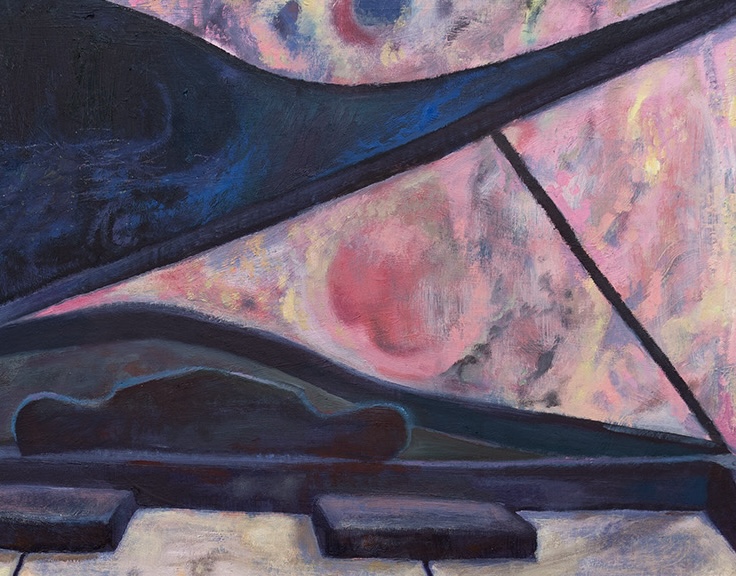

Even the way an instrument creates sound is similar to vocal cords, the movement of air.
Totally. Wind instruments are especially interesting because their sound can be the translation of a single breath. All the piano paintings are titled Notes on the Fall of Emphasis, which is pretty obviously a play on words regarding musical notes. But I also understand the title as describing the paintings as records. Like written notes on how to create emphasis; across surfaces, in different areas of a painting, through color, form, and composition. The title is in homage to a line in a poem by Ben Lerner, from his most recent book The Lights. In the poem he recounts an exchange with his young daughters about rhyming. The poem alludes to rhyming as just one way of emphasis can fall on words. I love this idea of emphasis as a physical force and as a result of surrounding conditions. I wanted to investigate this idea of emphasis being relative, a relation, a relationship, or a moment of relativity between two forms. The paintings of the dabbing Maestro are also about generating emphasis. I could go on and on about the dab as a form, but to break it down on a very basic level, holding one arm up, while hiding the face, down in the other arm, creates a dissonance of attitude, or paradox, that results in emphasis. A simultaneity of high and low in a physical form, like a wave of sound, or light. On another level the “High” of the Maestro against the “Low” of the dab as cultural signifiers, has a similar effect. If you zoom out and consider the Maestro with the pianos, you’ll see they have a similar composition– they rhyme.
![]()
![]()
Maestro (Little Star), 2023
oil on canvas, 20 x 24 inches
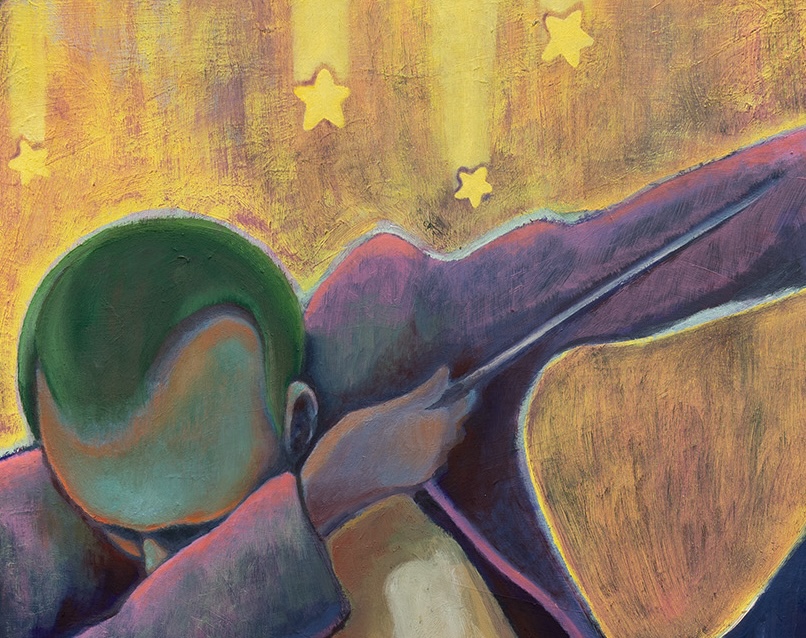

“I love this idea of emphasis as a physical force and as a result of surrounding conditions. I wanted to investigate this idea of emphasis being relative, a relation, a relationship, or a moment of relativity between two forms.“
The angle of the piano, this emphasis on a triangular shape also feels like the hands of a clock.
Yes! Very much so. This was a happy accident, but [referring to the angles in a work in progress] here it feels like the hands of a clock almost ticking and getting smaller as they recede in space.
Do you feel like your sculpture carries that same idea of emphasis with the objects that you use?
I do think so. In the poem I mentioned, Lerner briefly elaborates on other ways of creating emphasis that are above the level of a second grader. Reading that poem opened me up to the possibility that there are more abstract ways to create emphasis that might go completely unnoticed. Like when you enjoy a novel, and the narrative concludes and creates a feeling that is inexplicably more important that the tying together of the obvious plot points of the story. It would be impossible—and maybe totally pointless—to map the individual passages of text across the book that slowly and subtly built the conditions for the emotional resonance of the conclusion. The ending is impactful because that emotional arc is immediately mappable to us, if that makes sense. The way I'm thinking about the sculpture is within these kinds of relationships between things that can form subtle crescendo together, or maybe at times, the opposite of a crescendo.
Like an accumulation?
Yeah, of feelings and associative references. Probably the majority of the time, I don't fully comprehend it in a way I can name. I’m creating compositions or a form of rhyming between two forms and I think it's harder for me to name the other ways I'm creating emphasis, or allowing emphasis to fall. One of the ways I write about it, for instance with the piano, is that the piano creates an out-of-body experience because it allows the human to emote in a way that they wouldn't be able to with just their body. I think there's a paradox there. Embedded in that out-of-body experience there’s a subtle disembodiment that occurs, that exists through all technology. I would never want to make art about this, but as an example, it’s related to being hyper-present on your phone. Thinking about the way that technology and images create the potential for an unknowable disembodiment that runs parallel to, or mirrors, the extension of human will—or agency—that technology extends.
When you listen to music or you’re on your phone, it's like a willful disembodying.
Yeah. You're in the music. It's a willful disembodiment, for sure. But I question the consequence of that. I don't think it's damaging. I actually wouldn't even phrase it in such concrete terms. Maybe that’s why art is important? As the inconclusive record of some investigation. I'm wondering what the long term impact of that is on how humans evolve and how it impacts our relationships and ability to form them. We’re a species of imitation, but now we're constantly interacting with algorithms, these things that we can't even see. Sometimes that really fucks with my head.
I’ve been reading a book called “Immediacy: Or, The Style of Too Late Capitalism,” [Anna Kornbluh] which talks specifically about the ways in which art writing and even all media is beginning to reflect the way we consume images through our phones, and how there's little to no mediation between us and what we consume anymore because there's a lack of a critic or someone to interpret these ideas or artworks before they make it to us. It goes directly from the creator to the consumer, instead of there being any curation or mediation. I think about Tik Tok, specifically, as being incredibly dangerous because the algorithm isn't thinking, it's not an editor of a newspaper. There’s no filter between you and what's being put in front of you. It's all AI, and the AI isn't saying, “oh, we should feed them more of this.” If you will spend time with a specific kind of content, It will give you more of it. It just wants to keep you there. It's purely working on the mechanism of addiction, whether it’s a positive thing that you're being fed, something triggering you towards negative emotions, or telling you something you want to hear. We don't have that much agency with what we consume. It becomes our responsibility to be aware of what we’re bringing into our heads, but there’s a way in which these images are almost created to be seen and consumed before you can think about them.
It's interesting and weird. I've talked to some people about the way the New York art world operated before the internet. When someone had a show, no one would see any images of that show until Artforum came out a month later, usually with just one photograph. Everyone saw the show in person. So there was this story of the show that circulated through the city, and there was a slow digestion that took place over the course of the exhibition that wasn't just everyone seeing like 10 images in a scroll and moving on. It's easy to romanticize that, but I do wonder what it would have been like. I guess I’ll never know. People do still go out and see shows, but there’s this other media, this other layer to it.
That’s actually a good tangent to my show at Cordova [Perfectamundo]. The show had these two hand held radios. The radio was picking up a local am station that was announcing news updates in Barcelona, and depending on where you moved in the room, the frequency would go in and out. There were two stools. Viewers were encouraged to move around the show with the radio in hand, and the result was a kind of atmospheric sea of information and static. But this radio can be tuned to a handful of frequencies that are available nationally. Depending on where you are it delivers a mix of local and regional conditions [gestures to an emergency weather radio in the studio]. I like that there’s just information all around us.
That’s actually a good tangent to my show at Cordova [Perfectamundo]. The show had these two hand held radios. The radio was picking up a local am station that was announcing news updates in Barcelona, and depending on where you moved in the room, the frequency would go in and out. There were two stools. Viewers were encouraged to move around the show with the radio in hand, and the result was a kind of atmospheric sea of information and static. But this radio can be tuned to a handful of frequencies that are available nationally. Depending on where you are it delivers a mix of local and regional conditions [gestures to an emergency weather radio in the studio]. I like that there’s just information all around us.

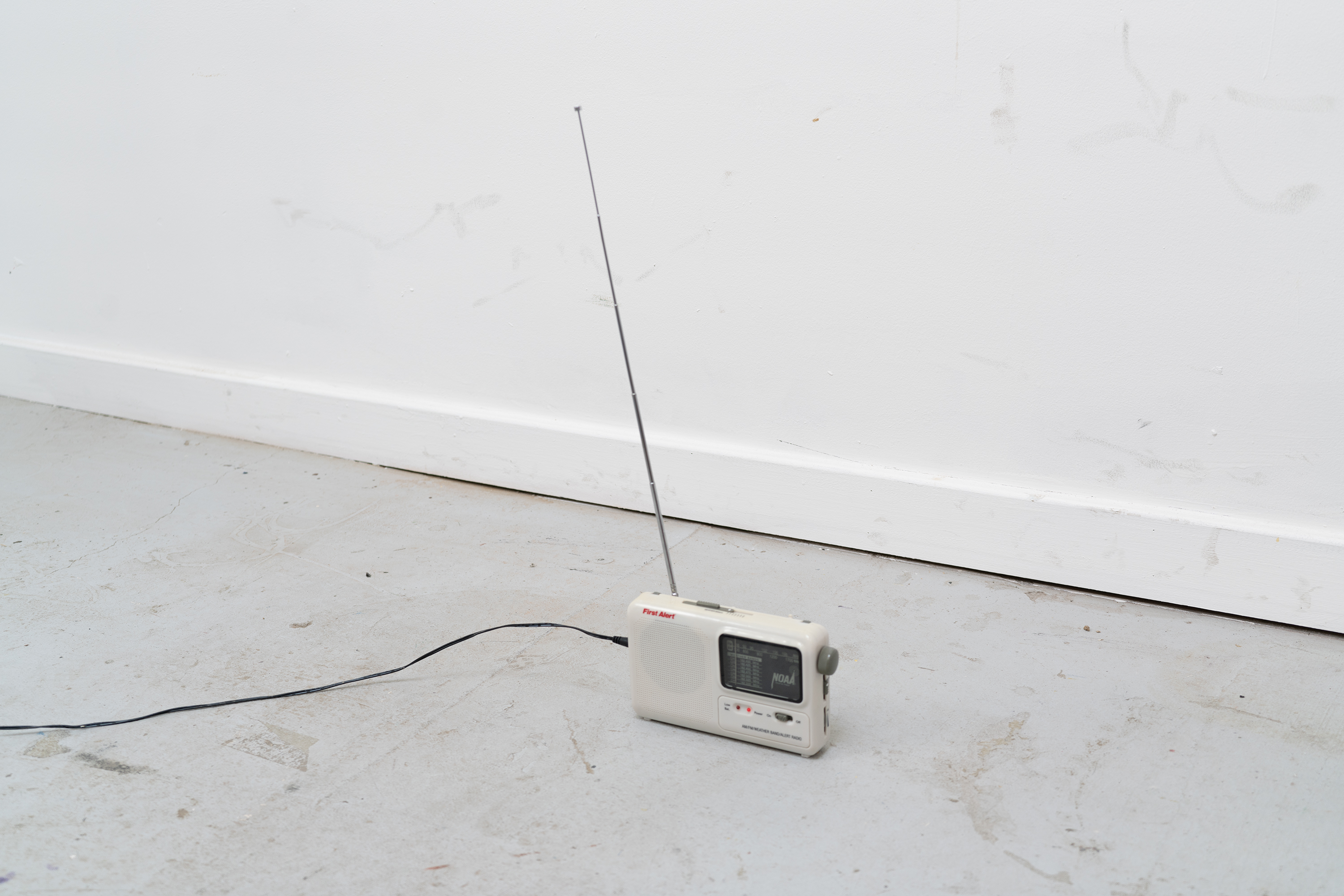

Installation view, Perfectamundo, 2019,
Cordova, Barcelona
You’re talking about your show Perfectamundo?
Yeah, the work I’m referring to included two Marlboro radios. Back then, I guess, cigarette companies were still allowed to produce and sell anything with their branding on it. So they made these portable handheld radios that just looked like cigarette packs. I love this relationship between information and the way we consume information now. And I wouldn't want to say that it was about how information is addicting, but more about information as something that is consumed. Information as a substance.
It’s funny that the dynamic of consumption is totally reversed; rather than an ad on the radio, the radio is coming from an ad.
Haha I love that. Yeah the radio waves of information kind of functioned as smoke.
This reminds me of your alphabet paintings, and many of your paintings, how there’s these accumulations of hearts or bubbles that fill the space, almost like a screen between the painting and the viewer. I almost see them as sound, creating a space or an aura, giving embodiment to the air.
Yeah, totally. It's funny, formally, what that layering and breaking of the atmosphere does. My favorites of that series achieve this odd quality of space, where it almost looks like there’s only two feet between the layers of the painting. The image might be of an expansive field, it and the illusion it holds is somewhat convincing, like you can understand that there is distance, but the space actually feels very shallow and compact, because of the way these layers interact.
Like separate planes within the painting.
Exactly. And that compactness charges the atmosphere of the painting with a resonance. It’s similar to the paintings of the pianos, which are also oddly shallow and squeezed within the frame– how the image resonates.
On the way over here, Olivia and I were discussing how coherent and singular your aesthetic voice is in both painting and sculpture. Is that illustrative style of your last few painting bodies of work a new development?
Nice to hear you can see a throughline. I was painting representationally all through college, and my use of color and feeling of overload might be consistent but I think these feel much more refined. If you looked at my paintings in college, you would see similarities, it would make sense if you said they're the same person. When I began painting again, towards the end of the shutdown, I started to use layering with more intention. The skin of that ballerina is all yellow underneath, and then there’s a mix of greens and reds on top of that. I'm using a mix of wax and Galkyd, and all these mediums to allow for that translucency. In the alphabet paintings, I was really trying to push that, where the first three layers of the painting were totally opaque, to cut out space, and then I would layer colors over those spaces to bring them towards the same tone. I think a lot of other painters are much more scientific about it; for me it was really intuitive, I have a basic understanding of color theory, and I work with that.
The use of semi-translucent layers isn’t something that I was doing when I was younger. It adds to their feeling of atmosphere. My recent paintings appear almost over the top colorful, but if you actually look at specific moments you might question what color it is you’re even looking at… There might be three colors happening at once that aren't actually mixed together. Separately the three colors are nameable, but in the way I layer them, they all kind of flicker in and out.
I don't want to get on a soapbox about this, but I do think that right now, in the art world, paintings are being made in a one to one relation to the photograph. I work with photographic reference sometimes, but I'm really conscious of trying to make slower feeling paintings that have moments which aren't photographic and are intentionally painterly.
The use of semi-translucent layers isn’t something that I was doing when I was younger. It adds to their feeling of atmosphere. My recent paintings appear almost over the top colorful, but if you actually look at specific moments you might question what color it is you’re even looking at… There might be three colors happening at once that aren't actually mixed together. Separately the three colors are nameable, but in the way I layer them, they all kind of flicker in and out.
I don't want to get on a soapbox about this, but I do think that right now, in the art world, paintings are being made in a one to one relation to the photograph. I work with photographic reference sometimes, but I'm really conscious of trying to make slower feeling paintings that have moments which aren't photographic and are intentionally painterly.



Initial M and the Transformative Power of Symbolism in Storytelling, 2021
oil on canvas, 64 x 48 inches
I think it's a prevalent mode of production because the art world uses images of paintings through screens, with PDF previews and what not. These images also inform a sense of scale, or lack of a sense of scale. Everything looks the same size on your phone. There's almost like a fast fashion aspect to some of the way in which it works.
Right, that's true, it's a product. Did you guys see that New York Times article about the market crashing? It gave me a little bit of hope for New York–maybe people will just want to make art again because no one's buying anything.
︎: @nobodylikesbeing
